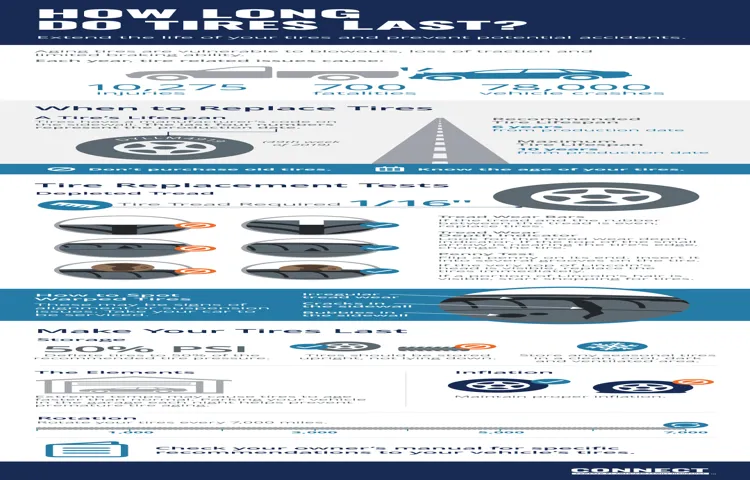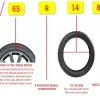Are you wondering how long it takes to change a tire? Well, the answer is not as straightforward as you might think. The time it takes to change a tire depends on several factors. Firstly, the type of vehicle you have plays a significant role in the tire change time.
A smaller car with compact tires can take less time than a heavy-duty truck with massive wheels. Next, the experience of the technician performing the change also affects the time it takes to complete the process. A seasoned mechanic could change a tire in under ten minutes, while someone new to the task might take longer.
The extent of tire damage is another factor that comes into play. Sometimes, it’s possible to repair a tire within a short period. However, if the damage is too extensive, a replacement will be necessary, which takes longer.
Lastly, the location of the tire change also matters. Changing a tire on the side of a busy highway is not comparable to doing it in a well-equipped garage. So, the time it takes to change a tire varies depending on the circumstances.
Overall, it’s crucial to have your tires regularly checked to avoid unexpected tire damage. You can never tell when you’ll need a tire change, and knowing how long the process takes can save you time, money, and stress.
Table of Contents
Introduction
If you’re wondering how long it takes to change a tire, the answer is, it depends. A simple tire change could take as little as 15-30 minutes, while a more complicated job could take an hour or more. Factors that affect the time it takes to change a tire include the type of vehicle, the number of tires being replaced, and the condition of the tires.
Other factors include the experience of the mechanic doing the job and the tools and equipment they are using. In general, a tire change involving just one or two tires should take less than an hour, while a complete set of four new tires could take up to two hours. However, with the right expertise, tools, and equipment, a tire change can be done quickly and efficiently no matter the type of vehicle you own.
Explanation of tire changes and why they’re important
Tire changes are an essential aspect of vehicle maintenance that is often overlooked. But why are they so important? Well, tires provide the only contact between your vehicle and the road, making them crucial for ensuring a safe and comfortable driving experience. Over time, tires can wear down and lose traction, leading to reduced performance and handling.
Additionally, worn tires can be more susceptible to blowouts and other forms of damage, putting you and your passengers at risk. By getting regular tire changes, you can ensure that your vehicle is equipped with the proper tires for the current weather and road conditions, helping to keep you safe on the road. So if you haven’t checked your tires recently, now is the perfect time to schedule a tire change and give yourself the peace of mind that comes with knowing your vehicle is equipped with the best possible tires.

Factors That Affect the Time It Takes for a Tire Change
If you’ve ever needed to get a tire change, you may be wondering just how long the process takes. The answer can vary depending on several factors. Firstly, whether you have a spare tire or not can greatly affect the time it takes.
If you do, the replacement process typically takes around 15-30 minutes, depending on the experience of the person doing the job. If you don’t have a spare, however, a tow truck may need to be called to take your car to a tire shop. This can add an hour or more to the process.
Other factors that can affect the time it takes for a tire change include the type of tire being replaced, the complexity of the job, and even the weather. It’s a good idea to be prepared and have a spare tire on hand, as this can save you time and hassle if you ever find yourself with a flat tire on the road.
Type of vehicle
When it comes to changing a tire, one of the most important factors to consider is the type of vehicle that you are working with. This can have a big impact on the time it takes to complete the task. For example, if you are changing a tire on a compact car, the process may be relatively simple and quick.
However, if you are dealing with a larger vehicle such as an SUV or a truck, the task may be more time-consuming and require additional tools or equipment. Additionally, the type of tire being changed can also play a role in the amount of time it takes. For instance, changing a tire with a standard rim may be faster than changing one with a locking lug nut.
Ultimately, the key to completing a tire change in a timely and efficient manner is to take into account all of the relevant factors and be prepared with the necessary tools and equipment.
Type of tire
When it comes to changing tires, there are various factors that can influence how long it takes. One of the most significant is the type of tire you are using. Different vehicles require different types of tires, which can affect how long it takes to change them.
For instance, if you’re using run-flat tires, they can be more challenging to change due to their stiffer sidewalls. Performance tires that are built for speed and precision might also take longer to change, given their unique tread patterns and designs. In contrast, all-season tires or regular passenger tires can be changed relatively quickly.
Additionally, the size of the tire and the complexity of the wheel design can also impact the change process. In any case, it’s crucial to have the right tools, equipment, and skills to ensure a speedy and efficient tire change. If you’re uncertain about the type of tire you’re using, it’s always best to consult your vehicle owner’s manual or a professional tire technician.
Ultimately, taking the time to understand your tires can help you stay safe on the road and prevent lengthy delays in changing them.
Mechanic’s experience and skill level
When it comes to changing a tire, the time it takes can vary depending on a number of factors. One of the biggest influences is the mechanic’s experience and skill level. An experienced mechanic who has changed countless tires over the course of their career will be able to do the job quickly and efficiently.
They will know all the tricks of the trade and have the necessary tools and equipment to make the job go smoothly. On the other hand, a less experienced mechanic may take longer to change a tire, especially if they are still learning the ropes. They may not be as familiar with the process or have the same level of confidence as more experienced mechanics.
So next time you’re in need of a tire change, it’s important to consider the mechanic’s experience and skill level to help ensure a speedy and successful job.
Average Time for a Tire Change
Have you ever wondered how long a tire change takes on average? Well, the answer can vary depending on a few factors. For a professional mechanic, the procedure usually takes about 15 to 30 minutes per tire. However, if the technician is inexperienced or working on a complicated tire replacement, the process may take longer.
Additionally, the type of vehicle and the size of the tires can also affect the duration of the tire change. It’s essential to note that changing tires requires skill and precision to ensure the safety of the driver and other road users. Rushing the process to save time can result in unsafe driving conditions and even accidents.
Therefore, it’s crucial to have your tires changed by a reliable and experienced professional. If you’re in doubt about how long a tire change for your vehicle might take, it’s always best to consult with a reputable mechanic.
Data from industry surveys, such as AAA
Industry surveys, such as AAA, have provided us with valuable insights into the average time it takes for a tire change. According to these surveys, the average time for a tire change is around 15 to 30 minutes. However, this time can vary depending on several factors, such as the vehicle’s make and model, the type of tire being replaced, and the experience and tools of the mechanic performing the tire change.
One important factor that can affect tire change time is the type of tire being replaced. For example, changing a regular tire without a puncture is likely to take less time than changing a flat tire. Similarly, replacing a tire on a larger vehicle, such as an SUV or a pickup truck, may require more time and effort than replacing a tire on a standard passenger car.
Another factor that can impact the time it takes to change a tire is the experience and tools of the mechanic performing the change. An experienced mechanic with the right tools can typically perform a tire change more quickly and efficiently than someone who is less experienced and has limited tools. Overall, while the average time for a tire change is around 15-30 minutes, it’s important to keep in mind that this time can vary widely depending on various factors.
Nonetheless, having this average time in mind can be helpful when budgeting time for routine maintenance or emergency tire changes.
Comparison between different types of vehicles and tires
When it comes to changing tires, the average time can vary depending on the type of vehicle and the type of tire. For example, changing a tire on a small car can take anywhere from 15 to 30 minutes, while changing a tire on a larger SUV or truck can take up to an hour or more. This is because the larger the vehicle, the larger the tire, and the more complex the process of removing and replacing it.
Additionally, the type of tire can also impact the time it takes to change it. Winter tires, for example, can be more difficult to change due to their thicker, more rugged design. Overall, it’s important to remember that tire changes require precision and care to ensure safety on the road.
So, whether you’re changing a tire on a small sedan or a large truck, take the time to do it right and stay safe on the road.
Ways to Speed Up the Tire Change Process
“How long do tire changes take?” is a common question for those who need a tire change. The answer is that it depends on a few factors. One factor is the type of vehicle you have – larger vehicles tend to take longer than smaller vehicles.
Another factor is the experience of the technician changing the tire. A skilled technician can change a tire more quickly than someone who is inexperienced. It’s also important to make sure that all the necessary tools and equipment are available and ready to use.
Finally, having a plan in place beforehand can speed up the process. Make sure you know where you want the tire changed, have your spare tire ready, and communicate any special needs to the technician. These factors can all work together to speed up the tire change process.
Properly maintaining tires
Proper maintenance of your vehicle’s tires is crucial for ensuring a safe and comfortable ride. While replacing worn-out tires is inevitable, there are a few ways to speed up the tire change process to minimize downtime. Regularly rotating your tires can extend their lifespan and prevent damaging wear and tear.
Additionally, periodically checking your tire pressure and maintaining the correct PSI can prevent punctures and blowouts, saving you time and money in the long run. Finally, keeping your tires clean and free of debris can prevent nail punctures and other common sources of tire damage, ensuring you can continue to hit the road safely and smoothly. By taking these steps to maintain your vehicle’s tires, you can avoid lengthy tire change procedures and get back to your journey faster.
Preparing ahead of time for the mechanic
When it comes to getting a tire change at the mechanic, there are a few things you can do beforehand to speed up the process. Firstly, make sure you have all the necessary information about your car, such as the make, model, and year. This will help the mechanic locate the correct tires for your vehicle quickly.
It’s also a good idea to research tire options beforehand and come prepared with a preferred brand or style. This can save time and ensure that you get the best tires for your driving needs. Additionally, removing any personal belongings from your car and ensuring that the spare tire is accessible can also help speed up the process.
By taking a few simple steps before heading to the mechanic, you can make the tire change process go more smoothly and reduce the amount of time you spend waiting around. So the next time you need new tires, make sure to prepare ahead of time to make the process as stress-free as possible.
Using a reputable mechanic and tire dealer
If you want to speed up the tire change process, it’s essential to use a reputable mechanic and tire dealer. Not all tire dealerships are created equal, and picking the right one can make all the difference. A trustworthy mechanic or tire dealer will have the experience and expertise to get the job done quickly and efficiently.
Plus, they’ll have all the necessary tools and equipment on hand, so you won’t have to wait for parts to be ordered. When searching for a mechanic or tire dealer, look for recommendations from friends and family, check online reviews, and ask about their qualifications and certifications. By doing your research, you can ensure you’re working with a reputable mechanic or dealer who will get you back on the road quickly and safely.
Conclusion
So, how long do tire changes take? Well, that depends on a variety of factors. Is it a simple tire rotation or a complete replacement? Is the mechanic experienced or a rookie? Is there a line of people waiting for their turn? It’s like asking how long it takes to cook dinner or how long it takes to finish a puzzle – it all depends on the specifics. But one thing’s for sure: it’s always better to be safe than sorry and take the necessary time to properly change your tires.
After all, you wouldn’t want to rush through it and end up with a flat tire on the side of the road, now would you?”
Summary of key points and final thoughts
When it comes to changing your car’s tires, there are a few ways to speed up the process. First and foremost, make sure you have all the necessary tools on hand, including a jack, lug wrench, and spare tire. It’s also a good idea to loosen the lug nuts on the tire you’re replacing before jacking up the car, as this will save you time and energy.
Another helpful tip is to position your car in a flat, stable area to make the process safer and easier. Additionally, consider investing in run-flat tires or tire sealant products, as these can prevent the need for a complete tire change altogether. By following these tips, you can reduce the time and frustration associated with changing your car’s tires, allowing you to get back on the road quickly and safely.
The main keyword used in this paragraph is “tire change.”
FAQs
How long does it typically take to change a tire?
The average time for a tire change is about 15 to 30 minutes, but it can vary depending on factors such as the type of vehicle and the condition of the tires.
Can I change a flat tire by myself?
Yes, you can change a flat tire by yourself if you have the proper tools and knowledge. It’s always a good idea to practice changing a tire before you need to do it in an emergency.
How often should I replace my tires?
It is recommended to replace your tires every 6 years, or when the tread depth reaches 2/32 of an inch. However, if you notice any signs of damage or wear, it is important to replace your tires sooner.
What are some signs that my tires need to be replaced?
Some signs that your tires need to be replaced include uneven tread wear, cracks or bulges in the sidewall, vibration while driving, and a loss of tire pressure.
Can I replace just one tire, or do I need to replace all four?
It is recommended to replace all four tires at the same time, but if you only need to replace one tire, it should be the same size, type, and tread pattern as the other tires on your vehicle.
How can I ensure that my tires last longer?
To extend the life of your tires, make sure to maintain proper air pressure, rotate them regularly, avoid overloading your vehicle, and drive conservatively to minimize wear and tear.
What should I do if I get a flat tire while driving?
If you get a flat tire while driving, pull over to a safe location and turn on your hazard lights. Use your spare tire if you have one, or call for roadside assistance if you don’t feel comfortable changing the tire yourself.



